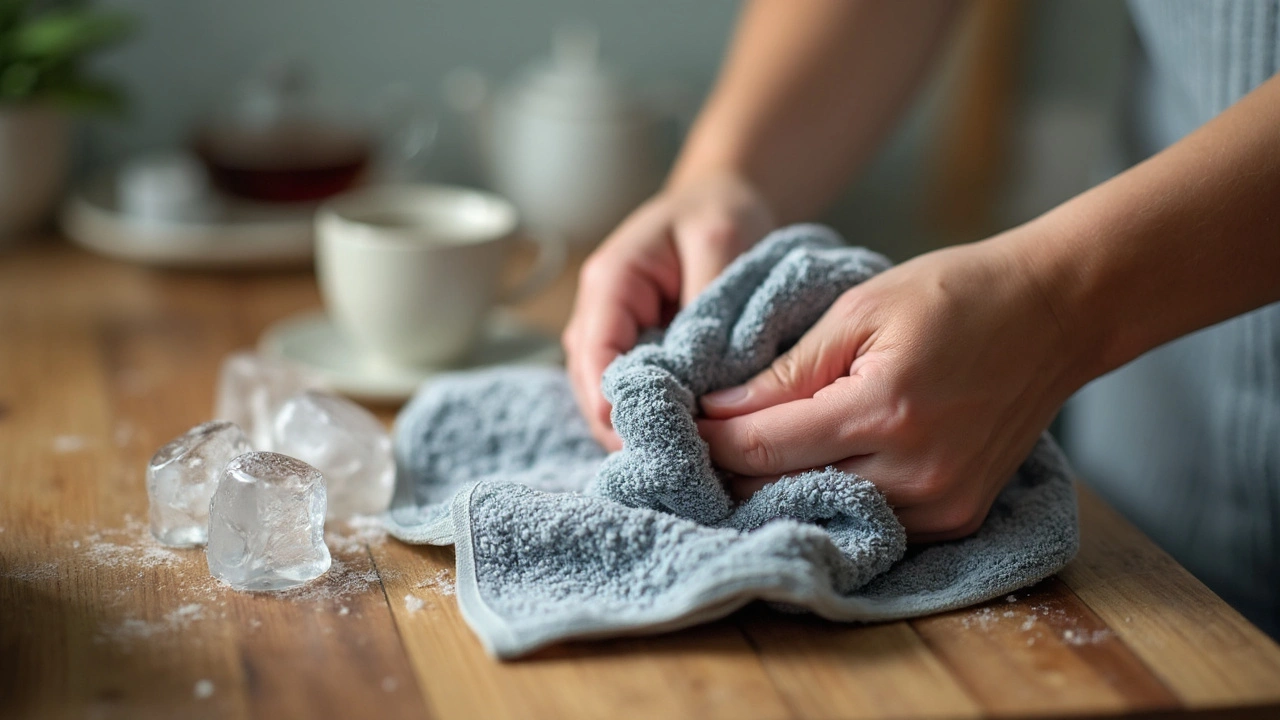
If you’ve ever slapped a cold pack on an itchy spot, you know how quickly the sting and urge to scratch fade away. There’s a good reason for that: cold actually changes the way nerves send itch and pain signals to your brain. Instead of your brain screaming, “Scratch here!” those nerve endings get confused and quiet down. That’s why chilly treatments aren’t just for sports injuries or swelling—they work wonders for annoying itching, too.
No fancy gadgets or expensive creams needed. Sometimes, all it takes is a clean washcloth soaked in cold water or a bag of frozen peas wrapped in a thin towel. Hold it on the itchy area for 5-10 minutes at a time. You’ll probably feel some relief almost instantly, especially if the itching is from bug bites, hives, or skin allergies.
- Why Cold Helps Soothe Itching
- Practical Ways to Use Cold Therapy
- Smart Tips for Better Itch Relief
- When to See Your Doctor
Why Cold Helps Soothe Itching
Ever wonder why you immediately feel better when you slap something cold on a bug bite or a rash? It's not magic—it's cold therapy at work, blocking those itchy signals sent by your nerves. Your skin has special receptors for temperature, itch, and pain. When you cool things down, you basically flood those nerves with new info, making it harder for the itching signals to get through. That's why a cold pack can work almost as well as scratching, but without damaging your skin.
One study from the British Journal of Dermatology found that cooling the skin below 20°C (68°F) dropped itching sensations dramatically for people dealing with eczema and hives. It’s because cold slows down the movement of histamines (those itch-triggering chemicals) in your skin and makes the nerve endings less sensitive. That's real science backing up what you feel when you grab an ice cube in a pinch.
"Applying cold can help reduce itch by numbing the area and interrupting the irritation-itch-scratch cycle."—American Academy of Dermatology
Beyond blocking itch signals, cold therapy tightens up blood vessels, which cuts down on swelling and redness. This combo effect ramps up the relief big time, especially if you’re dealing with an allergy flare-up or hives.
| Temp (°F) | Itch Relief (Reported By Users) |
|---|---|
| 68 | Significant relief |
| 75 | Moderate relief |
| 86 | Minimal relief |
So, the cooler you go (but not freezing your skin), the faster your itch should calm down. That’s why a chilled washcloth can seriously beat a room temp one for knocking out the urge to scratch.
Practical Ways to Use Cold Therapy
Cold therapy for itching relief doesn’t have to be complicated or expensive. Most folks already have what they need at home. The main goal is to cool the skin safely so you calm things down without causing more problems.
You don’t need fancy ice packs or special gels from the pharmacy. Some of the best itch relief methods are quick, simple, and use things most people find in the freezer. Here's how to do it right:
- Cold Compress: Wet a clean washcloth with cold water, wring it out, and press it against the itchy spot for about 10 minutes. If you have hives or a rash, this can bring fast comfort.
- Frozen Veggies: No ice pack? Grab a bag of frozen peas, wrap it in a thin tea towel, and use it instead. Never put icy stuff straight on bare skin—keep that buffer to avoid frostbite.
- Reusable Gel Packs: These are nice because they stay squishy and can mold to weird spots like elbows or knees. Always have one on hand for bug bites or allergic flare-ups.
- Cold Water Bath: For the truly desperate (especially with widespread itching), take a quick cool shower or soak in a tub of cool—not icy—water for 5 to 10 minutes. Don’t stay too long, or you’ll dry your skin out more.
For people with chronic itch issues, like eczema, it’s best not to overdo cold therapy. Use it a few times a day and always give skin a break in between. According to a 2022 survey from an American dermatology group, over 60% of people with itchy skin found that regular cold compresses worked better than over-the-counter creams for fast short-term relief.
Just remember, if you see blisters, open sores, or if the skin gets too numb, pause. Never fall asleep with a cold pack on. Keep those cold tools clean to prevent any skin infections down the road.

Smart Tips for Better Itch Relief
Cold therapy is pretty simple, but there are a few ways to make it work even better for itching relief. First, don’t put ice or anything frozen straight on your skin—it can actually cause damage or even frostbite if you leave it too long. Always use a thin towel or cloth as a barrier for safety.
- Keep the cold pack on the spot for only 5-10 minutes at a time. Give your skin a break between sessions, even if you’re tempted to keep it there longer.
- If your itching is from things like poison ivy or hives, use cool (not cold) water for baths or compresses. Sometimes, very cold water can make hives worse for some people. A patch test on a small area can help you figure out if you’re one of them.
- Store a few gel cold packs in your freezer. They stay soft and flexible and are way more comfortable than a bag of rock-hard frozen veggies.
- Avoid scratching while the cold therapy is working. Scratching just messes up your skin barrier and makes future itching worse.
- Combine cold compresses with other basic strategies, like wearing loose cotton clothes and using gentle, fragrance-free lotions after your skin warms up.
Here’s a quick comparison of popular cold options that actually help with itching relief:
| Cold Option | Pros | Cons |
|---|---|---|
| Gel cold pack | Reusable, stays flexible, easy to use | Needs to be stored in freezer, can get too cold |
| Frozen peas (bag) | Cheap, fits body curves, found in most freezers | Not reusable for eating, can leak water |
| Wet washcloth | Instant, super gentle, fits any body part | Doesn’t stay cold long, needs re-wetting |
If you’re prone to itching when exercising or in hot weather, try keeping small cold packs in a cooler for instant skin relief on the go. And always resist using extra pressure or rubbing—gentle contact is best for calming irritated nerves.
When to See Your Doctor
While cold therapy can calm down all sorts of run-of-the-mill itching, sometimes itchy skin is a sign of something more serious. If you find yourself reapplying that cold pack all the time and still don’t get relief, or if your skin looks or feels odd, it’s probably time to touch base with your doctor. You might be facing a condition that needs more than just a cold compress.
Look out for these red flags:
- Itching that lasts longer than two weeks, even after trying home treatment with cold therapy
- Itchy skin with rash, blisters, or swelling that spreads quickly
- Open sores, scabs, or signs of infection (like pus or spreading redness)
- Itching that comes with other symptoms like fever, night sweats, or unexplained weight loss
- Severe itching that interrupts your sleep every night
Chronic itching can be due to conditions like eczema, psoriasis, or even issues with your liver or kidneys—not just dry skin or allergies. According to the Mayo Clinic,
“Itching that lasts more than a couple of weeks or is severe enough to disrupt your day-to-day activities or sleep should be evaluated by a medical professional.”
Here’s a quick rundown showing when it’s more than just a simple itch:
| Sign/Symptom | What It Might Mean |
|---|---|
| Fever with itching | Possible infection or allergic reaction |
| Yellowing eyes/skin | Liver issues |
| Severe, constant scratching | Chronic skin disorder |
If you see any of these symptoms, don’t just keep reaching for the frozen peas. Check in with a doctor, preferably a dermatologist, to get to the bottom of your itching relief needs.

Cold therapy has been a lifesaver for me, especially during those times when an itch is just unbearable. There’s something truly soothing about the numbing sensation it provides. This article does a great job breaking down the science behind why it works, which many might not think about when they're just trying to find relief.
Has anyone else noticed that the relief feels almost immediate? Personally, I try to keep a clean cloth between the ice and my skin to avoid frostbite but still get the benefits. It’s simple enough but makes a huge difference.
Also, the tip about knowing when to see a doctor instead of just self-treating is so important. Sometimes an itch can be a sign of something more serious, and it’s always better to be cautious.
Did the article mention anything about how long one should ideally keep the cold compress on? I’m curious about that because sometimes I feel tempted to leave it on longer than recommended.
Very intriguing post! The idea that cold can physiologically calm the nerves responsible for itching makes total sense when you think about how our body processes sensations like pain and temperature. There’s a philosophical angle to this too — like how our perception shifts with external stimuli, and cold changes the way the brain prioritizes sensory input.
What really interests me is the balance here. Too cold and you might cause damage; too warm and the itch remains. The precise calibration of this kind of therapy fascinates me.
I'm also curious if anyone here has used alternatives to ice packs — maybe something like a cooling gel or other natural remedies? It’d be great to compare notes on what's most effective for long-term control.
It is commendable that the article elaborates on cold therapy as a method of alleviating pruritus, or itching, through physiological modalities. The methodical exploration of the mechanism — whereby cold application modulates nerve endings and diminishes the itch sensation — is of particular interest to practitioners and laypersons alike.
However, it is imperative to emphasize that while cold compresses can yield symptomatic relief, one must exercise caution in their application. Prolonged or inappropriate use may precipitate tissue damage or exacerbate underlying conditions.
Indeed, the advice on consulting medical professionals prior to employing cold therapy especially in cases of persistent or severe itch aligns with best practices in clinical care. This suggestion underscores the prudent balance between home remedies and professional intervention.
I appreciate how the piece underscores the simplicity and accessibility of cold therapy. Not everyone has instant access to medications or creams, but most can get their hands on something cold enough to provide relief. It’s a kind of reset button for irritated skin.
What strikes me is how our body's reaction to cold is almost instinctive — it interrupts the itch-scratch cycle which often ends up making things worse. This method taps into that natural response pretty brilliantly.
It might be worth experimenting with the timing and methods recommended here. Perhaps layering a wet cloth — not just a frozen pack — could offer more controlled cooling. Anyone else tried variations like this?
OMG, when I get those relentless itches, nothing feels better than something cold pressed on the skin. It’s like, all focus shifts away from the annoying itch to the coolness, which is a total relief! But sometimes, I've left it too long and ended up with red marks. 😬
Do you think the article should warn about how long is safe to apply cold? Because some people, myself included, just can’t resist keeping that ice pack on forever.
Also, just wondering if anyone's combined cold therapy with other topical remedies? Does that work together or is it better to keep them separate?
While the article offers a concise summary of cold therapy's utility, I found the lack of detailed contraindications troubling. There are several scenarios where cold application is not advisable, such as skin conditions with compromised circulation or neuropathy. It would have been prudent to highlight these risks more explicitly.
Furthermore, the effectiveness of cold compresses for different underlying causes of itching is variable and deserves mention. Not all itches respond uniformly to cold therapy, and blind reliance on this method may delay necessary medical attention.
Overall, while the article serves as an introductory guide, readers should approach cold therapy with caution and education.
Ah, cold therapy! A somewhat classical remedy dressed in modern scientific explanations. I do wonder if the article sufficiently accounts for the dramatic difference between transient relief and long-term treatment outcomes.
From my experience, cold compresses offer a theatrical, albeit fleeting, reprieve. But does icing the skin actually address the underlying trigger of the itch, or merely mask the symptom temporarily? This raises an important question about the true utility of such interventions.
Moreover, did the article touch upon the psychological effects of cold therapy? The initial shock of cold might provoke a fascinating neurological cascade, but this effect might be temperamental and short-lived.
Following up on my earlier question about alternative methods, I decided to try a gel pack with cooling agents without ice. It was gentler and still provided significant itch relief, especially for sensitive skin areas.
The article might have done well to explore such commercially available options next to traditional ice packs, as some people may have allergies or sensitivity to cold directly on the skin.
I'm particularly interested if anyone else has tried similar alternatives or what natural remedies they combine with cold therapy?
I must insist that all users ensure correct application to prevent frostbite and skin damage. Applying ice directly on the skin without a barrier violates safety protocols and could exacerbate lesions or cause burns.
Moreover, timing is of paramount importance; the compress should not exceed recommended durations, generally not more than 15 to 20 minutes at a stretch.
The article would benefit from including such explicit safety guidelines to uphold responsible self-care principles.
Echoing the safety concerns—definitely advocate using a thin cloth or wrap to protect skin from direct contact with cold packs. It’s easy to forget when you just want quick relief.
Also, I wanted to mention that sometimes alternating cold with lukewarm compresses helps reduce the itch flare-ups more effectively in my experience. This might be an interesting area for further experimentation or discussion.
I like that we're sharing these practical insights and safety tips. It makes the cold therapy approach feel more holistic. The alternating compresses technique sounds promising—I might give that a shot next time. It’s all about finding what works best for each of us.
Thanks to everyone for the thoughtful discussion—it really adds depth beyond the basic article content.